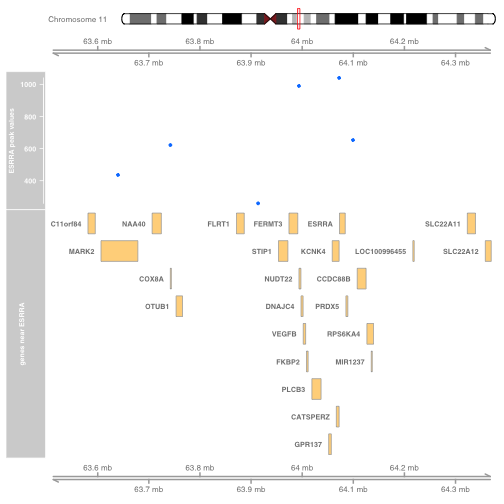Gviz for plotting data with genomic features
It is often of interest to display observed data in the context of genomic reference information. We’ll examine how to do this with the ESRRA binding data and Gviz.
First we load up relevant data and annotation packages along with Gviz.
library(ERBS)
library(Gviz)
library(Homo.sapiens)
library(TxDb.Hsapiens.UCSC.hg19.knownGene)
txdb = TxDb.Hsapiens.UCSC.hg19.knownGene
Genes in the vicinity of ESRRA
How can we identify a slice of the human genome containing ESRRA and some neighboring genes? There are various approaches; we’ll start by obtaining the ENTREZ identifier.
library(Homo.sapiens)
eid = select(Homo.sapiens, keys="ESRRA", keytype="SYMBOL", columns="ENTREZID")
## 'select()' returned 1:1 mapping between keys and columns
eid
## SYMBOL ENTREZID
## 1 ESRRA 2101
Now we obtain the addresses for the ESRRA gene body, collect addresses of neighboring genes, and bind in the symbols for these genes.
allg = genes(txdb)
esrraAddr = genes(txdb, filter=list(gene_id=2101)) # redundant...
esrraNeigh = subsetByOverlaps(allg, esrraAddr+500000)
esrraNeigh$symbol = mapIds(Homo.sapiens, keys=esrraNeigh$gene_id, keytype="ENTREZID",
column="SYMBOL")
## 'select()' returned 1:1 mapping between keys and columns
A quick check on the task with Gviz:
plotTracks(GeneRegionTrack(esrraNeigh, showId=TRUE))

The ESRRA binding peaks in this region
We obtain the ESRRA binding data for the GM12878 EBV-transformed B-cell and subset to events near our group of genes.
data(GM12878)
sc = subsetByOverlaps(GM12878, range(esrraNeigh))
sc
## GRanges object with 6 ranges and 7 metadata columns:
## seqnames ranges strand | name score col
## <Rle> <IRanges> <Rle> | <numeric> <integer> <logical>
## [1] chr11 [64071338, 64073242] * | 3 0 <NA>
## [2] chr11 [63913452, 63914077] * | 61 0 <NA>
## [3] chr11 [63741506, 63742754] * | 210 0 <NA>
## [4] chr11 [63992515, 63994725] * | 408 0 <NA>
## [5] chr11 [64098744, 64100083] * | 1778 0 <NA>
## [6] chr11 [63639263, 63640021] * | 2248 0 <NA>
## signalValue pValue qValue peak
## <numeric> <numeric> <numeric> <integer>
## [1] 69.87 310 32 1040
## [2] 52.48 123.72 1.785156 259
## [3] 18.24 59.652 2.022276 622
## [4] 9.04 41.001 1.910095 990
## [5] 9.03 19.758 2.075721 653
## [6] 8.65 17.481 2.031517 436
## -------
## seqinfo: 93 sequences (1 circular) from hg19 genome
Computing an ideogram to give context on the chromosome
This computation is slow.
idxTrack = IdeogramTrack(genome="hg19", chr="chr11")
Putting it all together
We start at the top with the ideogram to identify chromosome and region on chromosome to which we are zooming with observational and structural information.
plotTracks(list(idxTrack, GenomeAxisTrack(),
DataTrack(sc[,7], name="ESRRA peak values"),
GeneRegionTrack(esrraNeigh, showId=TRUE,
name="genes near ESRRA"), GenomeAxisTrack()))
